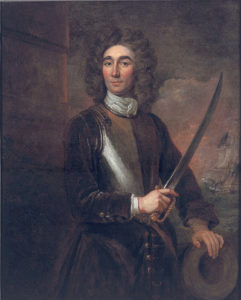Извините, этот техт доступен только в “Американский Английский”. For the sake of viewer convenience, the content is shown below in the alternative language. You may click the link to switch the active language.
As Lilia and I wondered around the Shrewsbury museum, we heard a song playing from a little room adjacent to a passageway, and went to investigate.
This is the song, shown on a screen there, with the story of the Admiral Benbow song on the walls —
Lilia instantly remembered that Admiral Benbow was the name of the fictional inn, featured at the start of R.L.Stevenson’s Treasure Island, although it was situated on the Penzance coast, rather a long way from land-locked Shrewsbury.

It turns out, Admiral Benbow was a native of Shrewsbury, and quite a character.

Born in 1653 in Shrewsbury, John Benbow joined the navy at 25. This was a great time to be at sea — with Britain ‘ruling the waves’, both with merchant navy and the military fleet.

Captain Benbow commanded several ships in the Nine Years War against France (end of 17c), and fought the French in the West Indies during the War of the Spanish Succession (beginning of 18c), as well as fighting against pirates and serving in the merchant navy. By 1701 he became an admiral.
Benbow comes across as an outspoken and brave character, and his exploits at sea earned him public notoriety. It was his last action that cemented his reputation and put his name on a few pub signs across England.
In 1702 he commanded several ships that fought the French off the coast of South America. Three captains refused to follow his orders to pursue enemy ships, while Benbow continued to command the battle, despite his leg being fractured by a shot. When the fleet returned to England, Benbow had the captains arrested and court-martialled.
He lived long enough to see them punished, but died soon afterwards, likely from the infection of his leg wound. Admiral Benbow is buried in Jamaica, but there’s a monument to him in St.Mary’s Church in Shrewsbury, paid for by public subscription, commemorating «a skillful and daring seaman whose heroic exploits long rendered him the boast of the British Navy and still point him out as the Nelson of his times.»


And, of course, a pub or two, and the song.
Come all you seamen bold
and draw near, and draw near,
Come all you seamen bold and draw near.
It’s of an Admiral’s fame,
O brave Benbow was his name,
How he fought all on the main,
you shall hear, you shall hear.
Brave Benbow he set sail
For to fight, for to fight
Brave Benbow he set sail for to fight.
Brave Benbow he set sail
with a fine and pleasant gale
But his captains they turn’d tail
in a fright, in a fright.
Says Kirby unto Wade:
We will run, we will run
Says Kirby unto Wade, we will run.
For I value no disgrace,
nor the losing of my place,
But the enemy I won’t face,
nor his guns, nor his guns.
The Ruby and Benbow
fought the French, fought the french
The Ruby and Benbow fought the French.
They fought them up and down,
till the blood came trickling down,
Till the blood came trickling down
where they lay, where they lay.
Brave Benbow lost his legs
by chain shot, by chain shot
Brave Benbow lost his legs by chain shot.
Brave Benbow lost his legs,
And all on his stumps he begs,
Fight on my English lads,
‘Tis our lot, ’tis our lot.
The surgeon dress’d his wounds,
Cries Benbow, cries Benbow
The surgeon dress’d his wounds, cries Benbow.
Let a cradle now in haste,
on the quarterdeck be placed
That the enemy I may face
‘Til I die, ‘Til I die.
Ralph Vaughn Williams used this song as part of his arrangement of sea shanties for the English Folk Song Suite.
One of Benbow’s sons, also called John, followed his father in the navy, briefly serving with him, and then sailing with a merchant ship, when he was captured on Madagascar and later on wrote one of the first descriptions of this island.
Wikipedia gives us an interesting ‘Russian Connection’ —
Benbow signed a three-year lease on Sayes Court in June 1696, a house belonging to diarist John Evelyn. Six months later, Evelyn wrote to a friend complaining, «I have let my house to Captain Benbow, and have the mortification of seeing everyday much of my former labours and expenses there impairing for want of a more polite tenant.»[55] In January 1698, Tsar Peter of Russia arrived in London to study British shipbuilding and seamanship. He and his entourage were provided with Sayes Court to reside in during their stay by William III. The Russians spent three months in London before leaving to tour the country. Benbow promptly asked for reparations from the Treasury, in order to be able to reimburse Evelyn and recover his own losses. He complained that the Russians had caused considerable damage to his house, with «much of the furniture broke, lost or destroyed».Christopher Wren was instructed to survey the property and declared it «entirely ruined». Benbow lost «twenty fine paintings» and «several fine draughts and other designs relating to the Sea» from his personal property. The Treasury eventually allowed payment of £350 9s. 6d. in compensation


